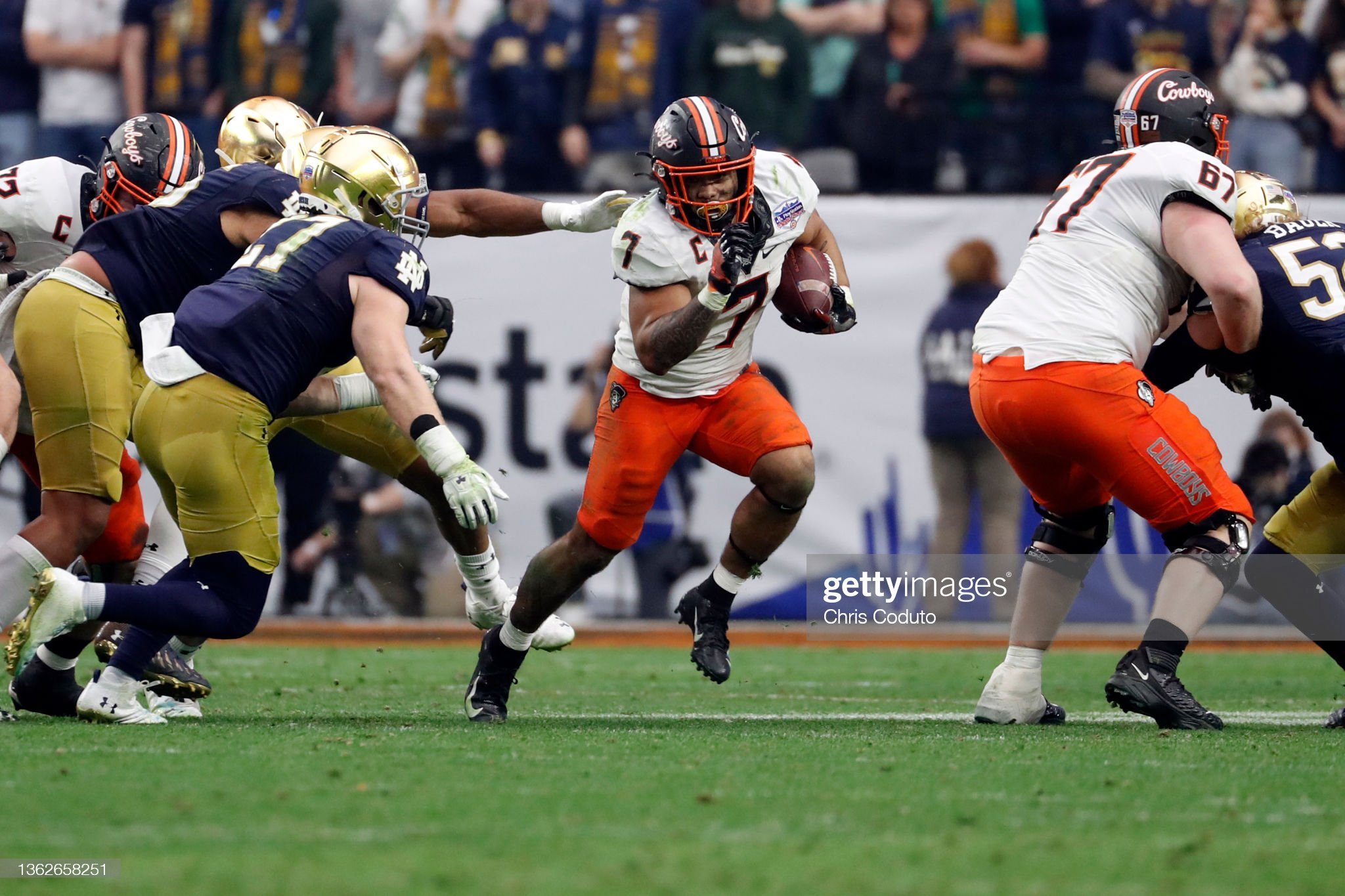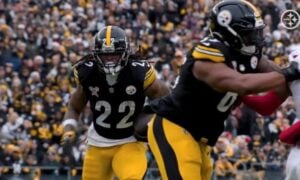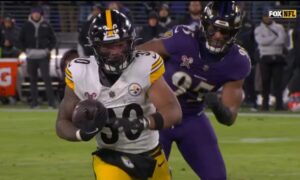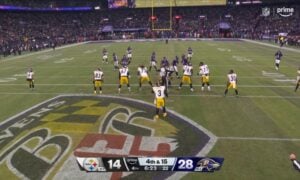#7 Jaylen Warren, RB, Oklahoma State (R-Sr.) — 5080, 207 lbs.
Measurements
NFL Combine
| Player | Ht/Wt | Hand Size | Arm Length | Wingspan |
|---|---|---|---|---|
| Jaylen Warren | 5080/207 | |||
| 40-Yard Dash | 10-Yard Dash | Short Shuttle | 3-Cone | |
| 4.55 | 1.56 | N/A | N/A | |
| Broad Jump | Vertical | Bench Press | ||
| 9’11” | 31.5″ | N/A |
Pro Day
| Player | Ht/Wt | Hand Size | Arm Length | Wingspan |
|---|---|---|---|---|
| Jaylen Warren | 5080/207 | 9 1/4″ | 29 7/8″ | 70 3/4″ |
| 40-Yard Dash | 10-Yard Dash | Short Shuttle | 3-Cone | |
| N/A | N/A | 4.42 | 7.13 | |
| Broad Jump | Vertical | Bench Press | ||
| 9’8″ | 34″ | N/A |
The Good
— Runs with a low center of gravity, able to shake off light contact in traffic without sacrificing momentum or balance.
— Fully commits to a running lane, doesn’t hesitate or give the defense time to adjust.
— Possesses good burst and acceleration to get to and through lanes, gets through them quickly when he hits them clean.
— Solid cutter, able to shift L/R as he gets vertical without losing speed.
— Embraces contact, not afraid to initiate with defenders or absorb hits if it means getting the extra yards.
— Plays pinball on runs, will try to bounce off tackles if not wrapped up by defender.
— Sees everything well in the open field, finds the lanes that allow him to avoid contact the longest while gaining yardage.
— A willing blocker and chipper who showed improvement in that area during lone season at Oklahoma State.
The Bad
— Doesn’t have great top speed, won’t make a lot of home run plays or win extended foot races.
— Lacks consistent vision behind the line, misses some gaps or outside lines and runs into traffic instead.
— Has to become more willing to kick it outside and try to evade players instead of choosing to run into contact and try to power through traffic.
— Doesn’t evade contact behind the line when defenders get through, has to have momentum and open space to shake off or evade defenders.
— Doesn’t break many tackles beyond arm tackle attempts by defenders. When he gets hit solidly, he’s going down.
— Minimal reps as a receiver.
— Size limits effectiveness as a blocker.
Bio
— Spent final season at Oklahoma State after two years at Utah State, two years at JUCO Snow College.
— Ran for 4,488 total yards and 45 touchdowns on 706 carries across his five-year collegiate career.
— 1,216/11 at OSU, 821/8 at USU, 2,451/26 at Snow College.
— Started 12 games appeared in 14 at Oklahoma State, appeared in 15 total games in two seasons with two starts at Utah State, appeared in 20 games with Snow College.
— 2021 stats (Oklahoma State, 14 games, 12 starts): 256 carries, 1,216 yards, 11 touchdowns, 25 catches, 225 yards
— 2021 Big 12 Offensive Newcomer of the Year, honorable mention Big 12 Offensive Player of the Year and All-Big 12 team selection.
— Selected as team captain lone season at Oklahoma State.
— Utah State stats (15 games, two starts): 151 carries, 821 yards, eight touchdowns, 20 receptions, 215 yards.
— 2020 Doak Walker Award Watch List with Utah State (nation’s top running back).
— Two-time Academic All-Mountain West selection at Utah State.
— Snow College stats (20 games): 299 carries, 2,451 yards, 26 touchdowns.
— Led junior college players with 1,435 rushing yards in 2018, was second with 15 touchdowns and an 8.6 yards per carry average.
— NJCAA Offensive Player of the Year and first team All-American selection in 2018, was the final WSFL (Snow College’s conference) Offensive Player of the Year before the conference dissolved.
— 3-star recruit out of Snow College and fourth-best JUCO running back in his class, chose Utah State over Hawai’i.
— 2-star recruit coming out of high school. Set the Utah state high school record for career rushing yards, first back to ever go over 3,000.
Tape Breakdown
Warren’s collegiate career is a journeyed one, but a constant throughout his three stops between high school and the Pittsburgh Steelers was production. Across five seasons, he put up almost 4,500 yards, and averaged nine touchdowns per season, working as a lead back from the junior college level up to a Power 5 conference in Division I.
Watching Warren, you see that his size and frame are more typical of a speed or one-cut back, and you also see that the first time he is able to hit an open lane. Warren’s game is built more on burst than it is foot speed, and you see that as he attacks a clearing made by his blockers. He gets to the lane and through it quickly when his teammates create one, and gets beyond the line to pick up chunk yardage before the defense can adjust.
Watch him in this clip against Boise State. Warren is up to top speed quickly when he sees the lane form up the middle, and gets to the second level before any Broncos can shed blockers and get over to block the path to open field. From there it’s a footrace down the sideline, and though he doesn’t have great speed and won’t win a lot of these long sprints down the field, he does hold everyone off to take this one all the way.
Warren doesn’t hesitate when he sees that big lane open, and makes sure to hit it before the opportunity is lost, like he does against Kansas State. Similar play to the prior one, where as the line is headed right, he sees a lane up the middle, and here, Warren uses his burst to get through the lane just before the Wildcats can shift back to catch him near the 20, and the play ends up going for 16 yards and a first and goal.
You’ll see in the Kansas State clip that Warren is also able to shake off some contact without losing too much of his speed or momentum. A powerful runner with a low center of gravity, Warren is able to run through arm tackles without getting taken off-balance or having to slow down considerably.
That’s when Warren is contacted by a defender, though. He is also able to make men miss with his ability to deliver deft cuts left and right that are very slight, but take defenders out of position to bring him down.
This cut against Baylor and star defender Jalen Pitre (selected in the second round of the draft) ends up netting Oklahoma State a touchdown, as Warren sees the safety coming around the edge, and is able to plant and cut inside the lunging Pitre to make it to the end zone.
What you see in this third down run against Texas is what you’ll normally see from him in delivering cuts. Warren is constantly shifting left or right to avoid obstacles, but does so without missing a step or having to slow down. On this carry, it’s a slight cut to the right to dodge his own lineman, who had disengaged from a block at the second level.
Warren employs those cuts in a similar way when he is running in the open field, which is where his vision is also at its highest. He has the ability to see the lanes in the open field that will keep him out of reach of contact for the longest duration, and uses that to gain additional yardage before defenders can run him down for a stop.
Across the four games I watched, this is the best example of Warren doing that. He gets upfield off the left side against Texas, and instead of going down just beyond the line to gain, he sees a lane back to the right and cuts to it, adding another almost 20 yards to the run before any Longhorns can finally get within reach to hit him.
Warren’s vision working behind the line does not match what it is in finding those open field lanes, however. There are gaps and running lanes that he will miss, instead choosing to run to a crowded area and into traffic, resulting in much smaller gains. When it is a large lane, like some of the ones seen above, you can count on him to hit it reliably on the majority of snaps, but he will have to improve his vision to see those smaller lanes, and learn how to hit them just as quickly and cleanly as he does the big ones if he is going to make big gains in the NFL.
Here is one of the bigger lanes that he missed, with a bonus illustration from the FOX crew broadcasting the contest against Texas. There is a clear opening to the right, but Warren cuts left and tries to hit a much smaller gap between his center and right guard, and ends up running in to this man and gaining nothing.
He faces similar challenges when it comes to a choice between forcing a gap inside or bouncing it outside into space. On this play against Baylor, there is only a slight opening to the right. There is room to bounce it out to the open field and try to gain something there, or win a one on one against Baylor’s Christian Morgan (#4) and really rip off a big gain, but Warren chooses not to go outside, forces the gap, and gains just a few.
Warren has to capitalize on his ability to find lanes and evade contact, because he does not excel in breaking anything stronger than arm tackles like you saw in his highlights above. When he gets hit, he is normally going down shortly after, and he doesn’t avoid many tackles in the backfield when someone gets through. Even when he chooses to try and power through somebody or initiates the contact himself, the tackle is normally made without incident.
Conclusion
Watching Warren, you see a player who profiles with his size and skills to be a one-cut, elusive back, but who tries to play the game like a larger, power back. That provides some benefits to his game, like a willingness to embrace contact if it means extra yards and a powerful, low center of gravity as a runner, but it also leads to some decisions with the ball that limit the amount of yards he can gain on a play.
If Warren is going to succeed in the NFL as an undrafted player, and make an active roster, he has to improve his vision first, and more consistently get to the open field, where he sees the best lanes well and uses his burst and cutting ability to get chunk yardage. He projects as somebody who will need a year on the practice squad to get NFL coaching and work on his game, before making a run for the active roster in his second year.
Games Watched: 2021: at Boise State, vs. Kansas State, vs. Baylor, at Texas








